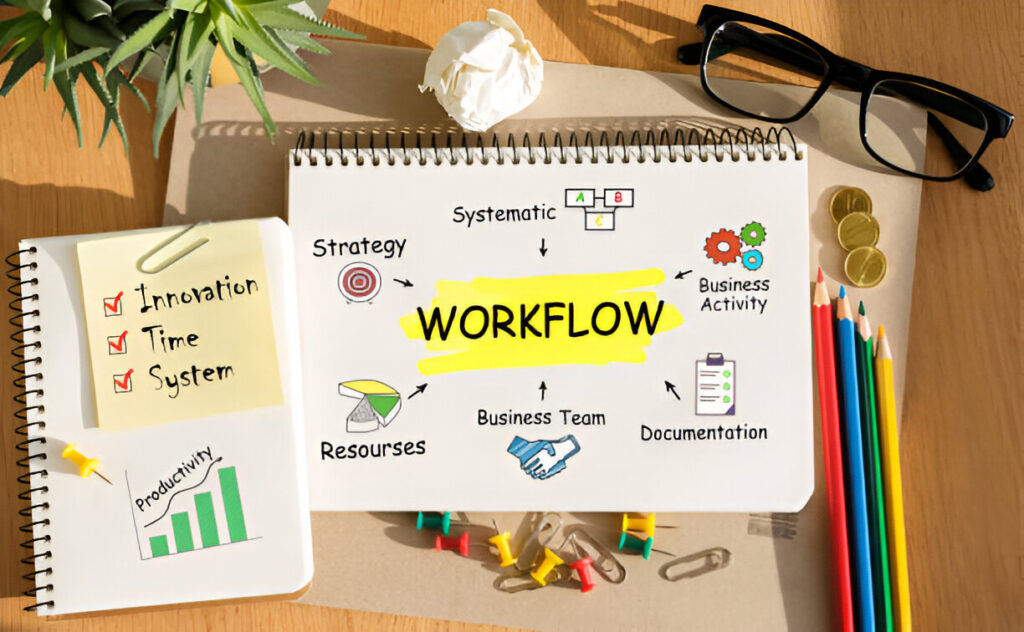Sales teams often face a common challenge: too much time is spent on tasks that don’t directly generate revenue. Studies show that sales professionals dedicate less than 40% of their time to actual selling. The rest is consumed by administrative work, manual data entry, and scattered communication. For modern teams competing in fast-moving markets, these inefficiencies can significantly limit growth.
The good news is that by streamlining workflows, businesses can transform how sales teams operate. This doesn’t require complete restructuring; small changes in processes and the right tools can deliver big improvements. Below, we’ll explore five proven workflow hacks that can help modern sales teams boost productivity, reduce wasted effort, and focus on what they do best: selling.
The Importance of Workflow Optimization in Sales
Optimized workflows serve as the backbone of a productive sales organization. When repetitive tasks are automated, communication is centralized, and processes are clearly defined, teams can close deals faster. On the other hand, poorly designed workflows lead to missed opportunities, delayed responses, and customer frustration.
Workflow optimization is not only about saving time; it’s also about creating consistency. By aligning sales processes with business goals, teams can improve efficiency and deliver a more predictable customer experience. This ensures that every salesperson, from a new hire to a seasoned closer, follows proven steps that drive results.
Workflow Hack #1: Automate Routine Tasks
Manual data entry, repetitive follow-ups, and CRM updates are some of the biggest drains on a salesperson’s time. By automating these routine activities, teams free up valuable hours to engage with leads and nurture relationships.
For example, automated email sequences can handle early-stage outreach, while CRM workflows update records instantly when a prospect takes action. Tools that integrate with your CRM can also trigger personalized messages, schedule reminders, and track lead behavior without manual intervention.
Even commission tracking, which traditionally involves spreadsheets and approvals, can now be automated. Businesses that adopt solutions like Salesforce Spiff Integration benefit from real-time visibility into incentives, allowing sales reps to see their earnings progress without wasting time chasing numbers. This transparency motivates performance while reducing administrative overhead.
Workflow Hack #2: Centralize Communication and Collaboration
Scattered communication is a silent productivity killer. When sales conversations happen across emails, Slack messages, and CRM notes, important details often slip through the cracks. Miscommunication not only slows down deals but also damages customer trust.
A centralized communication system ensures that every interaction, from the first touchpoint to the final signature, is recorded and accessible. Modern sales teams rely on collaboration platforms that combine chat, video calls, task assignments, and document sharing in one place. By unifying communication, teams respond faster, align better, and reduce friction across departments.
Collaboration doesn’t stop at internal messaging. Sharing customer insights across sales, marketing, and support ensures everyone has the same context. This eliminates duplicated efforts and allows teams to work toward the same goals. In turn, deals move forward with fewer bottlenecks.
Workflow Hack #3: Streamline Lead Management
Not all leads are created equal, and chasing unqualified prospects can waste a lot of time. Effective lead management means prioritizing the right opportunities. This is where structured lead scoring and CRM integrations make a difference.
Lead scoring assigns value to prospects based on behaviors such as website visits, content downloads, and past purchase history. When done right, it allows sales reps to focus energy on high-intent leads rather than spreading themselves thin across every contact.
Integrating lead management with marketing automation ensures that prospects receive timely, relevant nurturing content until they are sales-ready. Instead of pushing unqualified leads to the sales team, the system warms them up with resources, case studies, and educational material. This approach creates a more efficient pipeline and prevents wasted effort on cold prospects.
Workflow Hack #4: Implement Sales Playbooks and Templates
Consistency is crucial in sales, especially when multiple team members are handling similar types of prospects. Without standardized playbooks and templates, sales reps often waste time reinventing the wheel.
Sales playbooks outline the exact steps for prospecting, qualifying, presenting, and closing. They also provide guidelines for objection handling and follow-up strategies. Templates for proposals, contracts, and email outreach ensure messaging remains clear and aligned with brand standards.
By equipping teams with these resources, businesses reduce guesswork and shorten the ramp-up time for new hires. More importantly, sales reps can focus on building relationships instead of worrying about formatting proposals or drafting outreach emails from scratch.
Workflow Hack #5: Leverage Analytics and Real-Time Reporting
Decisions based on assumptions can hinder sales success. Modern teams need accurate, real-time insights to identify bottlenecks and optimize strategies. Analytics tools provide visibility into every stage of the sales process, from lead generation to closed deals.
Dashboards can highlight performance metrics such as conversion rates, deal velocity, and pipeline health. With this information, managers can coach teams more effectively, while sales reps gain clarity on their strengths and areas for improvement.
Real-time reporting also helps teams adapt quickly. If a campaign underperforms, managers can pivot strategies before more time and money are wasted. This agility ensures that sales operations remain competitive in an environment where customer expectations evolve rapidly.
Best Practices for Sustaining Sales Productivity
Implementing workflow hacks is only the beginning. To sustain productivity gains, sales leaders must establish practices that reinforce efficiency. Regular training and coaching keep teams updated on tools and best practices. Ongoing workflow audits help identify gaps and eliminate bottlenecks before they grow into larger issues.
Creating a culture that values productivity and accountability also plays a role. Recognizing achievements, celebrating wins, and providing clarity around performance expectations motivates teams to maintain consistent results. When employees feel supported and rewarded, they are more likely to adopt productivity-boosting tools and practices.
Conclusion
Boosting sales productivity requires more than just working harder. It demands smarter workflows. Automating routine tasks, centralizing communication, streamlining lead management, implementing playbooks, and leveraging analytics are proven strategies that empower teams to focus on what matters most: selling.
By adopting these five workflow hacks, modern sales teams can unlock new levels of efficiency, deliver better customer experiences, and achieve sustainable growth. The sooner these strategies are put into action, the faster businesses will see measurable improvements in performance and revenue.



